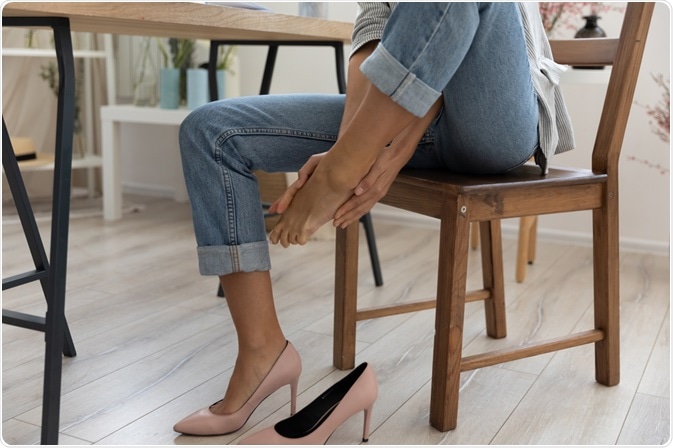There are several possible causative factors associated with metatarsalgia, also commonly known as forefoot pain. In some cases, a single factor is sufficient to cause the pain, whereas in other cases multiple factors are involved in the pathogenesis of the condition.
For example, an individual that is predisposed to the condition due to abnormal foot shape commonly experiences the onset of metatarsalgia symptoms following participation in high-impact sporting activities.
 Image Credit: fizkes/Shutterstock.com
Image Credit: fizkes/Shutterstock.com
Physical activity
Intense training or physical activity that places significant strain on the foot is a common cause of metatarsalgia. Any individual that participates in a high-impact sport is at risk of damage to the metatarsals and resulting pain. Wearing shoes that do not fit properly or are worn out heighten the risk of damage and pain.
In particular, runners rely on the front of the foot to absorb the force from the ground as they run, which stresses the foot and is more likely to result in metatarsalgia.
Foot shape and deformities
The natural foot shape of some individuals places more pressure on the metatarsals and, as a result, they are at risk of experiencing related pain. For example, a higher foot arch than normal or a second toe longer than the big toe changes the distribution of weight and can cause related pain.
Additionally, deformities of the feet such as claw foot, hammertoe or bunions can also cause metatarsalgia.
- Clawfoot, also known as pes cavus, refers to a very high arch of the foot, which can be inherited, idiopathic, or associated with a neurological disease.
- Hammertoe involves the abnormal position of all three joints in one of the toes, such that the shape resembles a hammer or claw. This can result from a number of factors and causes increased stress on the foot.
- Bunions, also known as hallux valgus, is a deformity at the base of the big toe, which can place extra stress on the ball of the foot and cause related pain.
Similarly, previous fractures to the metatarsal can change the structure of the foot and the way the weight is distributed. This can lead to stress on the metatarsal and related pain. A stiff ankle or Achilles’ tendon can also impact the weight distribution of the foot and cause pain related to the increased stress on the metatarsal heads.
Health conditions
Morton’s neuroma is a health condition that involves the growth of fibrous tissue around one of the nerves in the foot, typically between the third and fourth metatarsal heads. This is often caused by high-impact sports activities or wearing ill-fitting shoes, and can cause metatarsalgia. However, Morton’s neuroma is also associated with additional symptoms such as burning, numbness and tingling between the toes.
Other related health conditions include:
- Freiberg’s disease
- Arthritis
- Gout
- Diabetes
Other factors
Obesity can also be a causative factor for metatarsalgia. Excess weight places more stress on the forefoot and metatarsals with each step and movement, which can lead to pain over time.
Poorly fitting shoes that alter the natural distribution of weight on your foot can also cause metatarsalgia. For example, wearing high-heeled shoes is a common risk factor for women to experience pain in the forefoot. Additionally, shoes with a narrow fit or pointed-toe design can also cause problems.
References
Further Reading